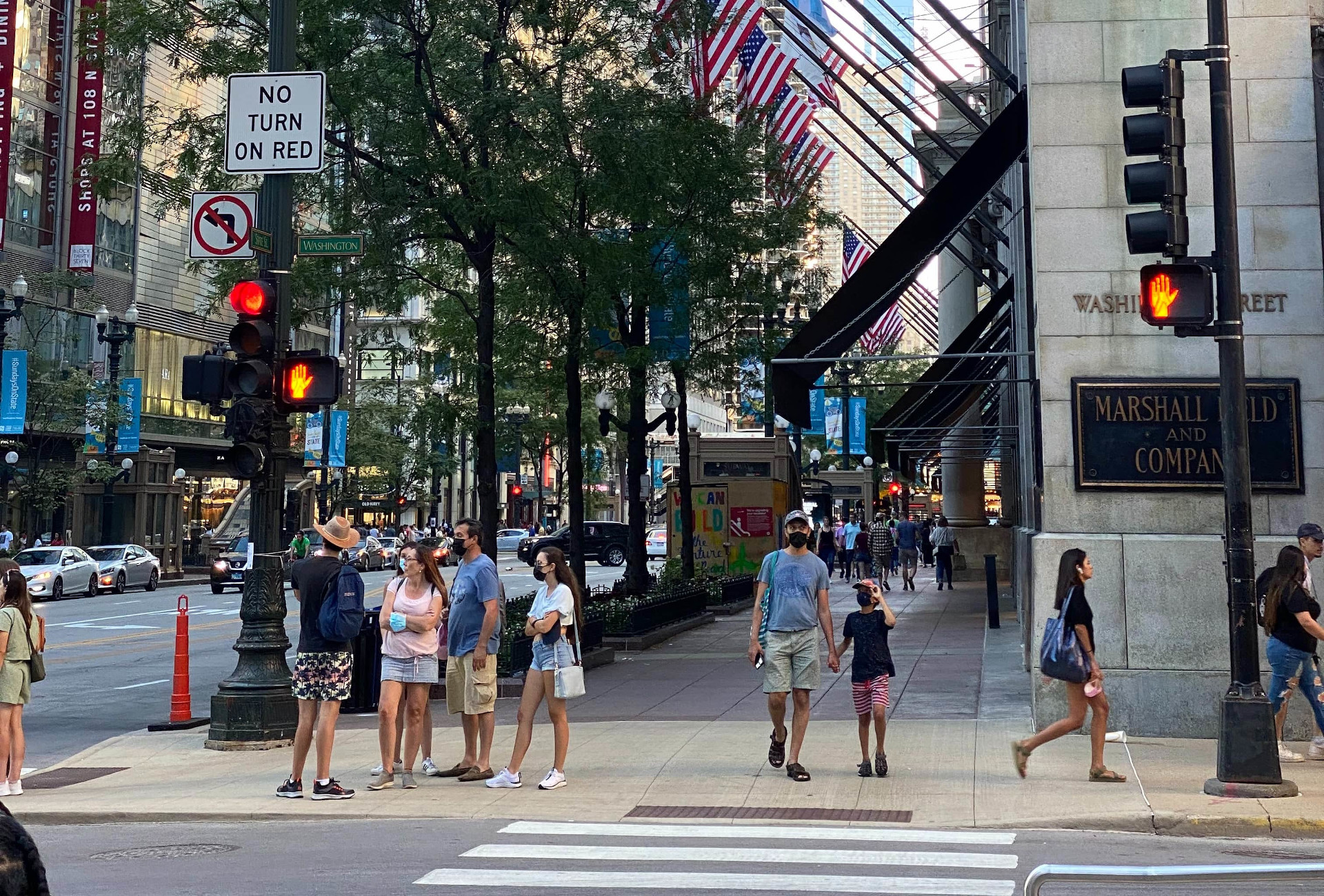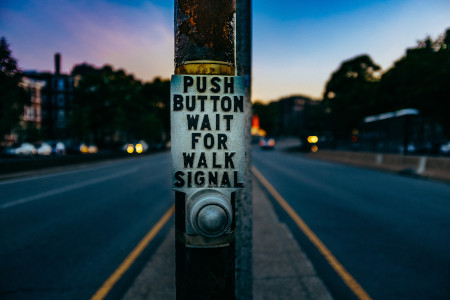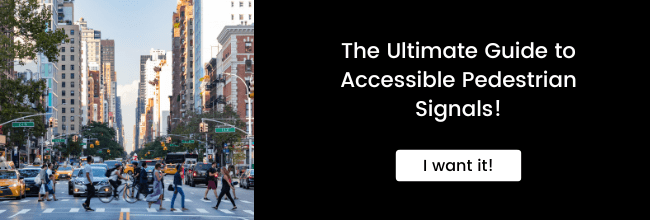
Blind and visually impaired pedestrians can face many obstacles and challenges when they navigate the streets, especially for crossing them.
Abled pedestrians cross the street in an automatic way without even thinking about it. They simply check out the color of the traffic lights and start walking as soon as the green man appears.
They “just” have to be careful when crossing the street by checking if a car is coming. For blind and visually impaired pedestrians, being careful is a state of mind. It never leaves them.
Because as soon as they step foot outside, the world can easily become inhospitable. But if you become aware of their struggles and issues, you’ll be able to make sure they can safely cross the streets of your city.
There are solutions that enable blind and visually impaired pedestrians to feel less anxious when crossing the street. First, let’s see what actions they need to take to safely cross the street.
1. Locate the beginning of the crossing
This actually represents the most challenging action for blind and visually impaired pedestrians.
They more or less know where they stand on the intersection. Other pedestrians rely on visual cues to spot the desired crossing and go towards it. But how can they know where the crossing begins?
They can rely on a locator tone that constantly emits sound.
The locator tone is used as an audio signage: it helps blind and visually impaired pedestrians find the beginning of the crossing.
Unfortunately, not all intersections are equipped with one. So what can they do when there’s no locator tone?
Either people with visual impairments are already familiar with the intersection and they know where the crossing begins. They may have tips like counting steps.
Or they can focus on the ambient sound: traffic with cars coming and going, people talking while waiting their turn to cross…
They can also ask another pedestrian to tell them where the crossing is.
2. Press the pushbutton
People with vision disabilities have now found the beginning of the crossing. But to know when they have the right-of-way, they need to actuate the accessible pedestrian signals.
This means finding the pushbutton on the pole. Pushbutton-integrated APS are indeed very common in the U.S.
How Accessible Are the Audible Pedestrian Pushbuttons of Your Crossings?
If the pushbutton is equipped with a locator tone then that’s easy. But if there’s no locator tone, they can just feel around to know where exactly it’s located on the pole. There’s no other specific beacon that can help blind and visually impaired pedestrians.
A vibrotactile arrow pointing in the direction of travel on the crosswalk is required on all APS. It’s directly installed on the pushbutton. But be aware that the alignment information isn’t accurate enough for blind and visually impaired pedestrians.
When the WALK sign is on, the arrow vibrates to dub the audio information from the accessible pedestrian signals. This is particularly helpful for deafblind pedestrians.
However in times of COVID-19, touching surfaces that may be contaminated can be dangerous for all pedestrians.
How Can Accessible Pedestrian Signals Become Responsive to COVID-19?
3. Rely on the accessible pedestrian signals
The accessible pedestrian signals are now activated. They provide audio information when the WALK signal is on.
Since they dub the warning traffic lights, their role is key. For them to properly work, they need to provide:
⊗ High-quality sound,
⊗ Clear information with the street name of the intersection,
⊗ Minimum volume of about 30 dB and a maximum volume of about 90 dB.
It’s to be noted that accessible pedestrian signals can’t be 5 dB louder than ambient sound.
When installers set up accessible pedestrian signals, they need to take into account the ambient sound when traffic is busy to make sure it perfectly matches real conditions.
Consequently, their volume depends on the intersections and their traffic.
The point is for blind and visually impaired people to properly hear the audio information provided without covering ambient sound.
Ambient sound actually helps them understand how the intersection is (if it’s long, busy with fellow pedestrians or cyclists…).
4. Get to the other side of the crossing
The WALK sign is on and the accessible pedestrian signal is dubbing it to let blind and visually impaired pedestrians know they can cross the street.
At this point, the goal is to walk straight without going off course. Two elements explain this:
⊗ The need to avoid bumping into other pedestrians,
⊗ The need to easily get across the street and arrive safely at the other side of the crossing.
One way to help them cross the street more easily is to set up a guiding sound corridor directly integrated in the accessible pedestrian signals.
With such a system, both APS from both sides of the crossing simultaneously broadcast audio information while blind and visually impaired pedestrians are crossing the street.
The guiding sound corridor wraps up them. They just have to follow the sound to easily reach the other side. It truly helps them walk straight.
Why Should Your Accessible Pedestrian Signals Have a Guiding Sound Corridor?
5. Rely on auditory cues
What happens when there’s no audible pedestrian signal? That’s actually more and more frequent as many cities decide to promote active mobility and encourage public transit.
One of their actions in doing so is to remove traffic lights. For blind and visually impaired pedestrians, this puts them at risk as accessible pedestrian signals are removed as well.
Consequently, cities need to guarantee their safety. It’s not because there’s no APS that they can’t remain autonomous and fully enjoy the city.
There are other auditory cues that can help people with vision disabilities cross the street. In Rouen, France, the city has installed audio beacons on poles at an intersection with a bus rapid transit system (BRT).
Blind and visually impaired pedestrians activate on demand the audio beacons with a remote control or a smartphone app so that they know where the crossing is located.
This system, created by French leading accessibility company Okeenea, uses flashing lights on top of the poles to alert motorists of the presence of vulnerable pedestrians.
Thanks to this innovative system, people with vision disabilities can still navigate this intersection despite the removal of traffic lights. Unfortunately, if there’s no audible markings, blind and visually impaired pedestrians tend to avoid this type of place.
6. Navigate their way among active mobility as blind and visually impaired pedestrians
We’ve just mentioned active mobility and there’s another situation that can be difficult to apprehend for blind and visually impaired pedestrians: shared streets.
Areas with different means of transport and active mobility: cyclists, scooters, motorists, streetcars…
How to Make Shared Streets Truly Shared by All?
In this situation where traffic lights and accessible pedestrian signals are missing, pedestrians with visual impairments need to be able to navigate in a “comfort zone”.
It consists in creating an obstacle-free pedestrian route. The goal is to enable all pedestrians to move around safely. In a comfort zone, pedestrians don’t run the risk of colliding with other users.
You now know 6 situations that can potentially be difficult for blind and visually impaired pedestrians while crossing the street. And you also have accessibility guidelines to make their mobility easier.
Want to know more about accessible pedestrian signals? Check out these articles:
Everything You Need to Know About Accessible Pedestrian Signals Regulation in New York City
How Do the Blind Safely Cross the Road?
Published on June 3rd, 2022
media

The point is for blind and visually impaired people to properly hear the audio information provided by the APS without covering ambient sound.
writer

Carole Martinez
Content Manager
stay updated
Get the latest news about accessibility and the Smart City.
other articles for you

Open Data Is Key to Fostering Universal Accessibility
Open data represents an opportunity for cities to reach universal accessibility. It shows the missing links of the mobility chain.
Our Audio Beacons Guide the Blind and Visually Impaired at the Helsinki Subway
The Helsinky subway improved their audio signage system by installing on demand and remotely activated audio beacons.
7 Good Reasons to Install Audio Beacons at Your Public Transport Network
Audio beacons are an efficient way to provide more autonomy to blind and visually impaired people. They can easily use public transport.

Will Remote Activation Become the Norm for Accessible Pedestrian Signals?
More and more cities like New York have been exploring remote activation to trigger accessible pedestrian signals.
share our article!
more articles

Disability Statistics in the US: Looking Beyond Figures for an Accessible and Inclusive Society
Disability Statistics in the US: Looking Beyond Figures for an Accessible and Inclusive Society Around 61 million adults in the United States live with a disability. Diving into disability statistics in the US will help us know exactly who is concerned and what...
Our Audio Beacons Guide the Blind and Visually Impaired at the Helsinki Subway
Our Audio Beacons Guide the Blind and Visually Impaired at the Helsinki SubwayOur audio beacons equip the new line of the Helsinki subway in Finland. They help blind and visually impaired people locate the points of interest of a station. For users with visual...

Will Remote Activation Become the Norm for Accessible Pedestrian Signals?
Will Remote Activation Become the Norm for Accessible Pedestrian Signals?Without pushbutton, there are no accessible pedestrian signals. That’s how APS work in the U.S. But more and more cities have been exploring remote activation like New York City. The Department...

Hearing Impaired People: a Multitude of Profiles for Different Needs
Hearing Impaired People: a Multitude of Profiles for Different Needs Did you know that hearing impaired people have several profiles and that the way they identify themselves is important? You may be familiar with deaf and hard of hearing people but for each of...
NEVER miss the latest news about the Smart City.
Sign up now for our newsletter.
Unsubscribe in one click. The information collected is confidential and kept safe.
powered by okeenea
The French leading company
on the accessibility market.
For more than 25 years, we have been developing architectural access solutions for buildings and streets. Everyday, we rethink today’s cities to transform them in smart cities accessible to everyone.
By creating solutions ever more tailored to the needs of people with disabilities, we push the limits, constantly improve the urban life and make the cities more enjoyable for the growing majority.



